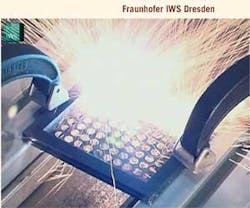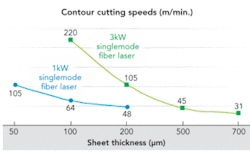Laser joining titaniumaluminum structures
Bremen, Germany–In common civil aircrafts, the passenger seats are attached to long aluminum tracks. Alternative seat track designs with higher corrosion resistance are becoming increasingly more interesting. Based on positive experiences with laser processing of dissimilar joints at BIAS (www.bias.de), Airbus and BIAS have begun cooperating on this task. The precise goal of the investigation is the development of a laser joining process whereby hybrid seat track geometry is assembled from titanium and aluminum profiles (see Figure 1). The process of welding has been optimized in such a way that both sides can be joined simultaneously. Furthermore no filler wire needs to be used because the aluminum profile possesses a symmetrical material reservoir.
The joining is carried out by two Nd:YAG laser beams, which are defocused to a spot diameter of 8.5mm. The welding of the titanium component is supported by taking advantage of gravity due to the upside down clamping of the components, with aluminum being on the top. Both symmetrically arranged working heads are equipped with laser optics and a shielding gas chamber. They can be further equipped with triangulation based sensors and a thermal camera for monitoring purposes. Dynamic control of the process parameters based on sensor data is currently planned.
Process development is supported by thermal and thermo-mechanical simulation using FEM-Software. The thermal simulation provides detailed information on weld pool characteristics, i.e. the area where no thermocouples can be used for measurement. It is also possible to get detailed temperature behavior at any position of the sample (an advantage compared to experimental measurement).
The thermal-mechanical simulation implements the static clamping conditions as well as downward forces exercised by moving rolls and provides information on mechanical stress and distortion. Figure 2 shows a snapshot of the calculated stress field during the joining process. The simulation not only helps to establish a better understanding of the process, but also enables changes to geometry or distortion minimizing measures to be realized more quickly.
High-speed remote laser cutting of thin sheet materials
Dresden, Germany–Fraunhofer IWS has developed a laser remote cutting process that takes advantage of developments in solid-state laser technology that have enabled the use of oscillating optics to rapidly scan a highly focused laser beam across a workpiece at extremely high speeds.
However, this process is a complete departure from conventional laser cutting, which relies on full penetration of the laser beam through the workpiece and assist gas to eject the molten material through the cut kerf. The remote process uses the interaction of the rapidly scanned laser beam to achieve workpiece sublimation or evaporation and, thus, the cut area is continuously ablated until it is completely separated.
One major advantage of this technique is the high processing speed, which cannot be matched even by the latest high-speed linear drive cutting machines due to their inherent mass inertia issues.
As Fraunhofer continues to develop this technology further, this new remote cutting technique could be applied to a wide range of industrial applications from cutting of automotive gaskets to electrical steels. As the maximum achievable thickness increases (Figure 2), the application areas will open up further, for example, cutting of steel filter screens and mesh materials.
The laser remote technique can easily cope with complicated contours. The possible material spectrum is wide and the heat affected zone is lower than with conventional cutting, due to the higher cutting speed. Compared to conventional punching, the advantages of the remote technique are lower costs for the tool making and the finish-grind, and the lower noise level.
The laser remote cutting technique has already been transferred into industrial applications. Together with the company Held Systems Deutschland, Fraunhofer has developed a novel generation of compact and flexible laser cutting systems for airbag tailoring. On these machines, material of 2.5m width is machined in a single layer manner at a speed of up to 20m/min with a remote guided CO2 laser beam. This represents an increase in processing efficiency in the range of 50–90%, compared to conventional multilayer cutting.
For more information, email Craig Bratt at [email protected] or visit www.ccl.fraunhofer.org. In Europe, email Thomas Himmer at [email protected] or visit www.iwsfraunhofer.de.




